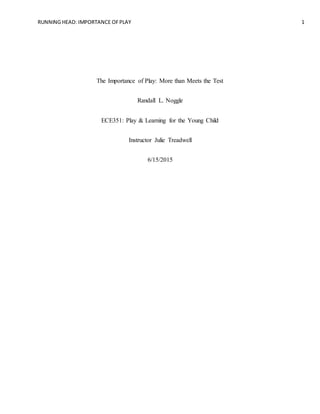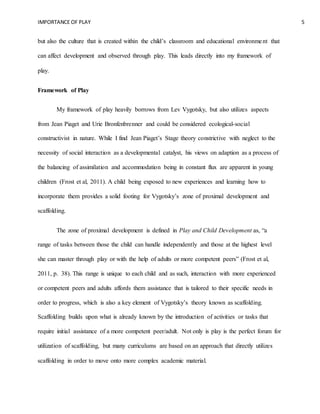This document discusses the importance of play for child development. It argues that play is not merely a way to pass time, but allows for higher levels of thinking and learning skills like self-regulation, social competence, language skills and independent learning. The document outlines developmental stages of play, discusses cultural influences on play, and presents a framework for play based on theorists like Vygotsky. It addresses challenges to play like standardized testing and lack of outdoor play. Research summaries show links between play and self-regulation abilities. The conclusion argues that play is integral to holistic child development and our education system should value it more.



![IMPORTANCE OF PLAY 4
Cooperative Children communicate goals, negotiate rules,
take turns, and decide on individual roles
within the activity (Frost et al, 2011).
Table 1
Cultural Influence Description
Culture is a complex and ever-changing concept. Among the numerous definitions,
Edward Taylor’s restated in Critical Reflections on Some Recent Definitions of ‘Culture’ is aptly
fitting within the educational context, “‘‘Culture, or civilization...is that complex whole which
includes knowledge, belief, [etc.] and any other capacities acquired by man as a member of
society’” (quoted in Jahoda, 2012, p. 290). Every child has their own beliefs that are shaped by
their familial culture, which is often (but not always) shaped by the culture that is present within
their community. Essentially, each child brings a unique perspective and view towards their
interactions based on their upbringing and what is and is not acceptable within their home and
local community.
In the confines of the educational system there is a combination of numerous cultures.
This creates a culture that is distinct and separate from each individual child’s culture, and
further, is different for every classroom. This cultural blending not only leads to the introduction
of ideas that may be foreign and novel, but also falls within the Vygotskian model of social
interaction being essential in development. This is explained by Wertsch (1985), “One of the
primary assumptions of Vygotsky's psychology is that understanding the social relations of an
individual is central to understanding the developmental path of that individual” (quoted in
Burkholder & Peláez, 2000, p. 7). Through this model it is not only the familial culture at work,](https://image.slidesharecdn.com/b9811386-e329-4f4e-bc8f-44815e4aefc3-151214004550/85/FINAL-PAPER-4-320.jpg)







